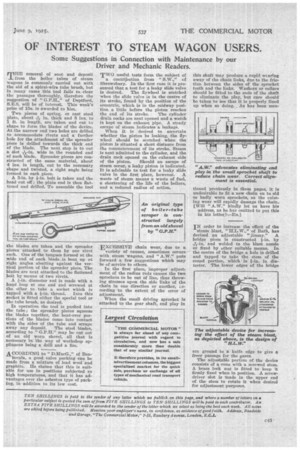OF INTEREST TO STEAM WAGON USERS.
Page 29

If you've noticed an error in this article please click here to report it so we can fix it.
Some Suggestions in Connection with Maintenance by our Driver and Mechanic Readers.
rIIHE removal of soot and deposit I. from the boiler tubes of steam wagons is commonly carried out with the aid of a spiral-wire tube brush, but in many cases this tool fails to clear the passages thoroughly, therefore the suggestion of " G.P.H.," of Deptford, S.E.8, will be of interest. This week's prize of 15s. is awarded to hint.
Two pieces of spring, or cast steel plate, about -A in. thick and 8 ins. to 1 ft. in length, are taken and cut to shape to form the blades of the device. At the narrow end two holes are drilled to accommodate rivets and a further hole for the attachment of the spreader piece is drilled towards the thick end of the blade. The next step is to cut a slot --in. wide in the rounded end of each blade. Spreader pieces are constructed of the same material, about 4 ins, in length, cut to the necessary shape and twisted, a right angle being formed in each piece.
A 3-in. by 4-in. bolt is taken and the head cut off ; the plain end is then flattened and drilled. To assemble the tool the blades are taken and the spreader pieces attached to them by one rivet each. One of the tongues formed at the wide end of each blade is bent up at right angles abutting against the vertical portion of the spreader piece. The blades are next attached to the flattened bolt by means of two rivets.
A 1-in. diameter rod is made with a hand loop at one end and screwed at the other to take a socket which is tapped with a isin. thread. Into this socket is fitted either the special tool or the tube brush, as desired.
In operation the tool is pushed into the tube ; the spreader pieces squeeze the blades together, the bent-over portions of the blades come into contact with the sides of the tube and serape away any deposit. The steel blades, according to " G.P.H." may be cut out of an old worn shovel, all that is necessary in the way of workshop appliances being a drill and a fire.
ACCORDING to " allacG.," of Ben becula, a good valve packing can be made from a mixture of lead wool and graphite. He claims that this is suitable for use in positions subjected to high temperatures, and that it has advantages over the asbestos type of packing, in addition to its low cost. TWO useful tests form the subject of a contribution from " S.W.," of Shrewsbury. In the first case it is presumed that a test for a leaky slide valve is desired. The flywheel is scotched when the slide valve is in the centre of its stroke, found by the position of the eccentric, which is in the midway position a little before the piston reaches the end of its stroke. The cylinder drain cocks are next opened and a watch is kept on the exhaust pipe. A steady escape of steam indicates a leakage.
When it is desired to ascertain whether the piston be leaking, the flywheel should be scotched when the piston is situated a short distance from the commencement of its stroke. Steam is next admitted to the cylinder, and the drain cock opened on the exhaust side of the piston. Should an escape of steam occur, a leaky piston is indicated. It is advisable to test for a leaky slide valve in the first place, however. A waste of steam means a waste of fuel, a shortening of the life of the boilers, and a reduced radius of action.
EXCESSIVE chain wear, due to a variety of causes, sometimes occurs with steam wagons, and " A.W." puts forward a few suggestions which may be of service to others.
In the first place, improper adjustment of the radius rods causes the two sprockets to be out of line, thus throwing stressea upon the side links of the chain in one direction or another, sccording to the extent of the error of adjustment
When the small driving sprocket is attached to the gear shaft, end play in this shaft may produce a rapid wcaring away of the chain links, due to the friction between the sides of the sprocket teeth and the links. Washers or collars should be fitted to the ends of the shaft to eliminate the play, but care should be taken to see that it is properly lined up when so doing., As has been men tioned previously in these pages, it is undesirable to fit a new chain on to old or badly worn sprockets, as the existing wear will rapidly damage the chain. [Will " A.W." kindly let us have his address, as he has omitted to put this in his letter_S—En.] IN order to increase the effect of the
steam blast, "H.L.N17.," of Bath, has devised an adjustable "jimmy." A bridge piece is constructed i-in. by 3 1st -in• and welded to the blast nozzle or fixed by other suitable means. In the centre of the bridge a hole is drilled and tapped to take the stem of the coned portion, which L9 1-in. in diameter. The lower edges of the bridge are ground to a knife edge to give a freer passage for the gases.
The adjustable portion of the device consists of a cone with a screwed stem. A brass lock nut is fitted to keep it firmly fixed when in position. A screwdriver slot is made in the upper end of the stem to rotate it when desired for adjustment purposes.






























